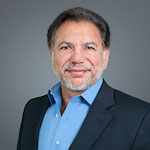Adult Stem Cell Therapy & Platelet Rich Plasma
PRP for Orthopedic Injuries Explained
PRP stands for Platelet Rich Plasma and while relatively new with its introduction to Orthopedic injuries, is in fact not new to the veterinarian, dental and plastic surgical fields. While some of the earliest athletes benefiting by its use and application were Kentucky Derby, Belmont and Preakness Stakes entrants, you might have heard of the use of PRP by the likes of Hines Ward, Pittsburgh Steelers, Tiger Woods, just to name a few.

In fact competitive athletes have been clued into this healing cocktail, an injections that is created all from your own blood. That’s right! No artificial or substances that are not from your own body!
What is PRP?
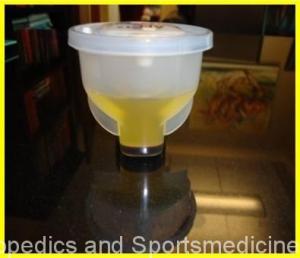 Well, it’s a concentrated injection of a small amount of plasma from your blood wit concentrated platelets. The concentrations vary upon processing technique and the substances in it vary based also on processing technique. Some have white blood cells, while others do not. The same is true for red blood cells and stem cells.
Well, it’s a concentrated injection of a small amount of plasma from your blood wit concentrated platelets. The concentrations vary upon processing technique and the substances in it vary based also on processing technique. Some have white blood cells, while others do not. The same is true for red blood cells and stem cells.
There are ample animal studies supporting its use. The clinical studies have been controversial.
Dr. Bennett founder of Bennett Orthopedics and Sportsmedicine. Regenerating the Youth in You!-Points out that the definition or PRP established by the American Red cross is a concentration of platelets 2.5xs normal blood and suggest that an absolute amount should be around 1,000,000 per volume standard. Yet, even that definition does not differentiate between those that have white blood cells, red blood cells and those that don’t.
Thus, the clinical studies are varied. He notes that when he served on the Editorial Board of the Journal of Arthroscopy, that there are various types of studies ranging from case studies to prospective randomized controlled studies. Interestingly, Dr. Bennett notes studies that have hit the orthopedic literature lack one basic common denominator, many don’t define well PRP and many have been compared across different definitions and he adds, concentrations and the inclusion or exclusion of certain substances like red blood cells, white blood cells and fibrinogen also vary amongst studies.
Dr. Bennett has been using PRP and various admixtures of it for 8 years. Initially, he would use it just with surgical procedures, yet, 6 years ago he started introducing it as injections in the office. This procedure takes about 50 minutes. He was enlightened after hearing a presentation on it in Warsaw, Poland.
What are Platelets?
Platelets are small, nonnucleated bodies in peripheral blood that are known primarily for their role in blood clotting. Platelets contain a number of proteins, cytokines, and other bioactive factors that initiate and regulate basic aspects of wound healing. Normal platelet counts in blood range from 150,000/ul to 350,000/ul. Plasma is the fluid portion of blood and contains clotting factors and other proteins and hormones.
Platelets which when introduced to an injury site explode and give off growth factors or cytokines regulate wound healing and tissue regeneration. There are numerous growth factors or messages given off. The names of many of these are very scientific, examples include, bone morphogentic protein and transforming growth factor. There are over 1500 cytokines in blood alone. Each growth factor or message has a specific tissue that it stimulates more-so than others on the same tissue. Tissue can include bone, collagen, ligament, tendon, cartilage and muscle.
However, Dr. Bennett notes that when combined together, as is naturally found in your blood but at lower concentrations per volume, may be a better regenerative cocktail than single factors isolated and injected.
Various Names for PRP
Many terms have been utilized; “plasma rich in platelets , “platelet concentrate”,, “platelet gel”, Platelet-rich plasma, “fibrin glue”, ACP, Orthokine™ and spinning blood. They all vary slightly and the best definition remains to be elucidated.
Tissue Injury
When tissue is injured there are 3 stages of healing; inflammation, proliferation, and remodeling. The inflammatory stage begins with tissue injury and platelets initiate the clotting mechanism and begin to secrete growth factors, or healing messages. Various hormones and enzymes stimulate the blood vessels to expand, this allows bigger cells like white blood cells and macrophages into the site to clean up the debris. Fibroblasts are found through- out the body and are stimulate to lay down the basement substance called collagen. If healing stops here, we scar.
If the process carries out in satisfactory fashion, we can regenerate our own tissue. You may have noticed with a cut, sometimes you may have scarred and others you can’t tell that you were ever injured there-here you have regenerated the skin.
Formulation of PRP
Platelet-rich plasma can only be made from anti-coagulated blood. It cannot be made from clotted whole blood because platelets become part of the clot. Platelet-rich plasma also cannot be made from serum. Serum is the clear liquid part of the blood that remains after blood cells and clotting proteins have been removed; the serum contains very few platelets and differs from plasma as it may not have all the clotting factors and hormones that plasma has.
Ok the process!
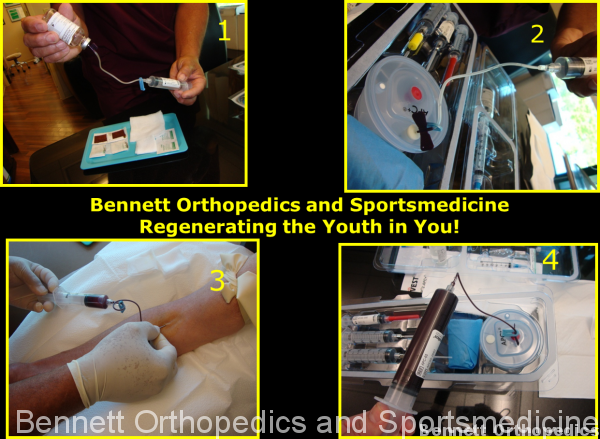
Firstly, blood is drawn from your vein. This is the same as donating a pint of blood or 400 ccs or getting lab work done. Then the blood is added to a patented container with anti-coagulant. The container is placed into a centrifuge and spun. Spinning can be one or two cycles. The time and strength of the spin vary amongst companies. The first centrifugation step separates the red and white blood cells from plasma and platelets .The second centrifugation step further concentrates the platelets. Some commercially available systems use bovine thrombin to activate the clotting mechanism. An important point is that clotting leads to platelet activation, resulting in release of the growth factors. This is an exogenous mechanism , when combined with Cacl to activate them immediately. However, platelets when they come in contact with collagen typically release their growth factors over 12 days, the intrinsic activation pathway.
Glue from your blood?
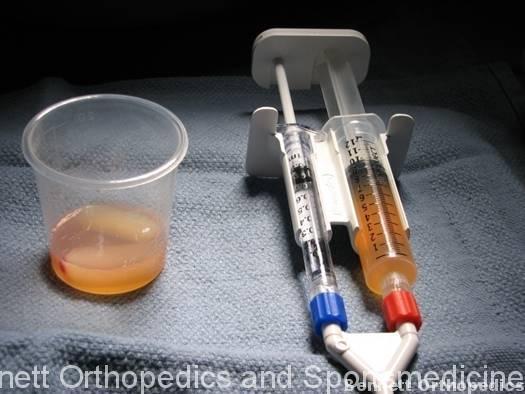
Dr. Bennett can also make glue from your own plasma. This is done in similar fashion. He utilizes this technique when he performs rotator cuff repair to help with the healing process and also when he performs Total shoulder replacement and total knee replacement to help with the tendon healing.
Effects of PRP on Soft Tissues
Effects of PRP on Tendon
Several recent studies have clearly shown that PRP positively affects gene expression and matrix synthesis in tendon, meaning that the native cells called tenocytes are stimulated to produce collagen and elastin.
Effects of PRP on Muscle
Several cytokines contained in PRP have a positive effect on muscle healing. Accelerated satellite cell activation and increased diameter of regenerating myofibers are noted in muscle contusions treated with PRP.
Serial Injections
The effect of serial injections should be explored further, however, at Bennett Orthopedics and Sportsmedicine, serial injections are utilized at different time intervals following injury and with arthritic conditions. In addition, different PRP admixtures are utilized for different tissue injuries and at different times and depending upon acute or chronic conditions.
CURRENT CLINICAL APPLICATIONS
Currently, the majority of orthopaedic applications for PRP as utilized by Dr. Bennett include: tendon, cartilage, ligament injuries-both acute and chronic, osteoarthritis and intra-operative augmentation to accelerate healing. Specifically, he has treated rotator cuff tears, shoulder arthritis, tennis elbow, golfer’s elbow, knee cartilage injuries, knee ligament injuries, plantar fasciitis and Achilles tendonitis. He has even treated carpal tunnel in this fashion.
Have you ever had lubricating injections for your knee? Dr. Bennett has noted a better outcome for knees treating them with PRP rather than lubricating injections-visosupplementation.
Cortisone for tennis elbow?
Watch out-PRP has been shown to work better!
Some clinicians have advocated the use of ultrasound guidance for needle localization and confirmation of the placement into the tendon injury. This is exactly what Dr. Bennett does; he has an MSK Sonosite ultrasound designed for musculoskeletal injuries in his office. He can isolate the tendon tear and see it with the ultrasound. The needle is also visualized and can be seen entering the tear site within a millimeter of the tear.
Osteoarthritis
Can PRP help osteoarthritis? You bet! At Bennett Orthopedics, we have a 93 percent responder rate. Most patients have 60 percent improvement with the first injection. The knee has 3 compartments, medial, lateral and patella. Each affected compartment requires one injection for each compartment. Interestingly, Dr. Bennett has had promising results in mild, moderate and severe arthritis. The severe group responds around 80 percent of the time. He notes if malalignment is present, bracing may be indicated. In more severe situations he advocates stem cell injections.
Cartilage Injuries
Injuries to cartilage of the knee, hip, shoulder, ankle and elbow have been treated at Bennett Orthopedics and Sportsmedicine with PRP, successfully. Cartilage, there are two types; articular cartilage which is the cartilage that is found in all joints (ok-not all eat chicken-but if you have had a drumstick-the white shiny cap is articular cartilage-that is what articular cartilage looks like when it is normal) and fibrocartilage, the type found in your meniscus. Did you know you have a meniscus in your shoulder? Fibrocartilage is also found in the spine and pelvis amongst other areas.
Dr. Bennett has had success with injecting PRP into cartilage injuries. In addition, he has utilized it with arthroscopic surgery noting a better cartilage matrix for cartilage repair techniques with PRP than without, especially with microfracture.
The meniscus tear is more difficult to treat, albeit, with minor tears and small tears Dr. Bennett has success with PRP and allowed the patient to avoid surgery.
Acute Ligamentous Injuries
A very provocative area notes, Dr. Bennett is the treatment of partial thickness tears of the anterior cruciate ligament(ACL) and medial collateral ligament. H ehas successfully helped patients avoid surgery by injecting PRP into partial tears.
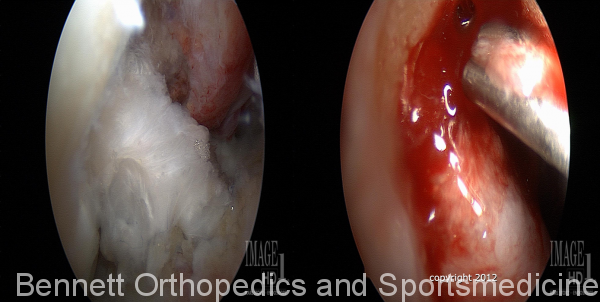
Acute Muscle Injuries
Hamstring injuries and calf injuries as well as groin pulls have been treated by Dr Bennett with success. Treating these injuries is very important to get to him in a timely fashion and also the type of PRP that is utilized is very important.
Total Knee Arthroplasty
Absolutely, if you didn’t already know that the majority of Dr. Bennett’s patients walk following total knee replacement without a cane in 2 weeks-you should! There is less cost for rehab and patients can return to recreational activity very quickly and to work in most cases. One caveat, while he utilizes PRP for accelerated healing, he also utilizes the glue he can make from your plasma to help the tendons heal and diminish blood loss. Interestingly, he notes that PRP diminishes pain in the post-operative period for most surgical procedures he does and diminishes Rehab by 50 percent. Ahh, but if you choose the minimally invasive technique, you will realize this benefit and many patients can walk without a cane in 2 days……..this is a special surgical technique, whereby, Dr. Bennett does not violate surgically the tendons that allow you to walk, when placing the implants.
Anterior Cruciate Ligament Reconstruction
A complete disruption of the Anterior cruciate ligament tear should not be treated with PRP alone. Partial tears have been treated by Dr. Bennett successfully numerous times when in fact, they may have been directed to surgery in other institutions. The partial thickness tear may create instability and depending upon what portion of the ligament is involved, may cause laxity in different knee flexion angles.
Acute Achilles Tendon Repair
Yes, PRP can be a very effective preventative treatment for those with Achilles tendinopathy. Once the Achilles tendon has ruptured, usually the result of chronic micro-trauma, results are quite varied. We have utilized PRP in an effort to return a tendon that has chronic granulomatous changes into healthy tendon. In the short term, Bennett Orthopedics and Sportsmedicine has had early success with this intervention. Long term follow-up is still to be determined, yet early and intermediate results are very promising. In fact, Dr. Bennett has used PRP as an adjunct with surgical Achilles tendon repair with good results.
Rotator Cuff Repair
Since 1995, Dr. Bennett has been performing arthroscopic rotator cuff repair for all sized lesions. He has had good to excellent results depending upon the size of the tear. More importantly, he recognizes that the integrity of the tissue he is dealing with can affect outcomes and many chronic tears have poor tissue. Since Dr. Bennett has been utilizing PRP in conjunction with arthroscopic rotator cuff repair, he has noticed a reduction in rehabilitation times by 50 percent, decreased post-operative pain and earlier increased strength.
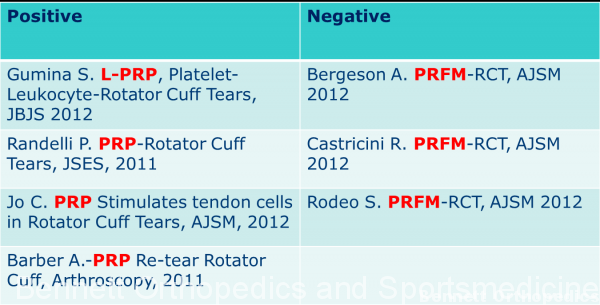
For complete tears, PRP is not efficacious alone without surgery. For partial tears, Bennett Orthopedics has been able to avert surgery for many patients.
PRP and Sports
In international athletics, IGF-1 which is found in PRP and is stimulated by human growth hormone had originally been prohibited, that is athletes couldn’t get PRP without violating performance enhancing drugs regulations. Human growth hormone is prohibited. However, the IGF-1 in PRP has a very short half-life and has no performance enhancing attributes. So PRP is now allowed to be utilized in Olympic athletes. Read more about optimizing your health, energy and athletic performance, legally and within the parameters of rules and regulations under Bennett Orthopedic and Sportsmedicine article on Staying Healthy, Vitalized and Young with bioidentical hormone supplementation and healthy diet.
Dr. Bennett’s immediate services area is localized to Sarasota, Bradenton, Venice, North Port, Englewood and Lakewood Ranch, Florida. With easy access to Tampa-St. Petersburg Airports, as well as Ft Myers airport, his reach extends to Naples, Port Charlotte, out-of-state and International patients.
PRP Pricing
Please be aware the PRP Procedure price DOES NOT include the office visit or the ultrasound. Most insurance companies do NOT typically pay for PRP procedures. We will bill your insurance company for the office visit (99213 or 99214) and the ultrasound (76681). If your insurance should apply any amount of those charges to patient responsibility (copay, coinsurance, deductible, etc.) then you will be responsible for those charges. The price of the PRP covers the cost of the PRP kits, Centrifuge, processing, Local Anesthesia, Phlebotomist and the actual procedure of injecting the Platelet Rich Plasma.
